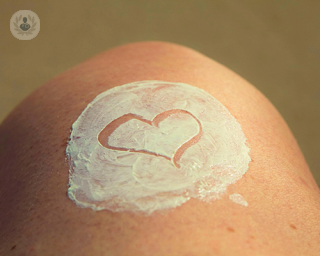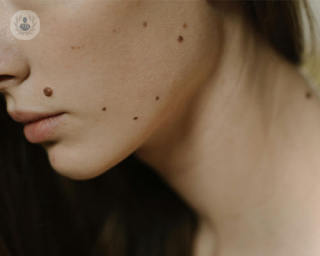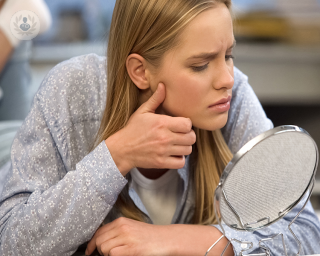What are moles?
Moles are pigmented spots which appear on the skin. They can often appear during childhood or adolescence without a known cause. Most moles are nothing to worry about and only become a concern when they change colour, size, or shape.
In some cases, people prefer to have them removed for aesthetic reasons, but this is largely done through the private sector as the NHS do not offer cosmetic mole removal. It is also worth noting that moles may also fade or disappear over time, and sometimes can darken during pregnancy. If you see noticeable changes in a mole, it is always best to have it checked by your doctor or dermatologist.

What do moles look like?
Moles can be varied in size, shape, and colour. They can be flat or raised, and most moles are oval or round-shaped. They may also have a smooth or rough texture, and have hair growing from them. Moles should be checked out by a doctor if you notice the following:
- A change in shape
- A change in colour or a separation of colour
- Bleeding
- Itching
- Crusting of the skin
- An increase in size
- The mole becoming more ‘raised’
What are the causes?
Moles or nevus occur when melancocytes, the pigment-producing cells of the skin, grow in clusters. Exposure to the sun influences their appearance, shape and size. Those who are fair-skinned are more likely to develop moles.
Can moles be prevented?
Monitoring sun exposure can prevent the appearance of some types of mole.
What is the treatment for moles?
The patient's dermatologist should keep track of the patient's moles, checking all those which change colour and shape or cause pain, or itch or bleed. If any of these symptoms present, the dermatologist may suggest mole removal as a precaution, in order to prevent melanoma developing. This operation is performed on an outpatient basis.
02-16-2015 10-30-2023Moles
Dr Nicola Clayton - Dermatology
Created on: 02-16-2015
Updated on: 10-30-2023
Edited by: Conor Lynch
What are moles?
Moles are pigmented spots which appear on the skin. They can often appear during childhood or adolescence without a known cause. Most moles are nothing to worry about and only become a concern when they change colour, size, or shape.
In some cases, people prefer to have them removed for aesthetic reasons, but this is largely done through the private sector as the NHS do not offer cosmetic mole removal. It is also worth noting that moles may also fade or disappear over time, and sometimes can darken during pregnancy. If you see noticeable changes in a mole, it is always best to have it checked by your doctor or dermatologist.

What do moles look like?
Moles can be varied in size, shape, and colour. They can be flat or raised, and most moles are oval or round-shaped. They may also have a smooth or rough texture, and have hair growing from them. Moles should be checked out by a doctor if you notice the following:
- A change in shape
- A change in colour or a separation of colour
- Bleeding
- Itching
- Crusting of the skin
- An increase in size
- The mole becoming more ‘raised’
What are the causes?
Moles or nevus occur when melancocytes, the pigment-producing cells of the skin, grow in clusters. Exposure to the sun influences their appearance, shape and size. Those who are fair-skinned are more likely to develop moles.
Can moles be prevented?
Monitoring sun exposure can prevent the appearance of some types of mole.
What is the treatment for moles?
The patient's dermatologist should keep track of the patient's moles, checking all those which change colour and shape or cause pain, or itch or bleed. If any of these symptoms present, the dermatologist may suggest mole removal as a precaution, in order to prevent melanoma developing. This operation is performed on an outpatient basis.


Why do we get moles?
By Professor Ramia Mokbel
2024-12-15
Nearly everyone has moles - small pigmented growths on the skin that vary in shape and size - but it is important to keep an eye on them in case they change. Leading London dermatologist Professor Ramia Mokbel explains. See more


Mole screening for skin cancer: what is the dermatologist looking for?
By Dr Ravi Ratnavel
2024-12-15
If you have more than a handful of moles on your body, you should be regularly self-examining them to monitor any suspicious changes. If you do feel concerned, you should visit a dermatologist for an expert opinion and a procedure called mole screening. Our expert dermatologist Dr Ravi Ratnavel explains what he looks for when assessing the skin for cancer. See more


All about benign moles, and how to tell when they're not
By Dr Minal Patel
2024-12-15
A mole is a textured bump, patch (macule) or nodule on the skin that is skin-coloured, darker, or differently coloured than the surrounding skin due to a cluster of melanocytes or nevus cells. Moles are exceedingly common, and can be anywhere on the body — you’d be hard-pressed to find someone who doesn’t have at least one mole somewhere. While some moles can be cancerous, the majority are benign. See more


Mole mapping: what to expect
By Dr Ben Esdaile
2024-12-14
The best mole mapping procedure is a combination of both full body digital photography and dermoscopy. Dermoscopy is a non-invasive skin surface examination using a microscope that allows skin structures to be magnified that are not normally seen with the naked eye. The aim of mole mapping is to detect skin cancer as early as possible. Dermatologist Dr Ben Esdaile gives us the ins and outs of mole mapping and how to know if a mole is harmless or potentially a cause for concern. See more
Experts in Moles
-
Dr Kapil Bhargava
DermatologyExpert in:
- Skin cancer
- Alopecia
- Moles
- Dermoscopy
- Mohs surgery
- Cosmetic dermatology
-
-
-
Mr Nicholas Parkhouse
Plastic surgeryExpert in:
- Scars
- Moles
- Skin cancer
- Facelift
- Breast reduction
- Tummy tuck (abdominoplasty)
-
- See all

The Priory Hospital - part of Circle Health Group
The Priory Hospital - part of Circle Health Group
Priory Road, Edgbaston, Birmingham B5 7UG
No existe teléfono en el centro.
By using the telephone number provided by TOP DOCTORS, you automatically agree to let us use your phone number for statistical and commercial purposes. For further information, read our Privacy Policy
Top Doctors

Derma Reading
Derma Reading
Shepherds Hill, Woodley, RG6 1FE
No existe teléfono en el centro.
By using the telephone number provided by TOP DOCTORS, you automatically agree to let us use your phone number for statistical and commercial purposes. For further information, read our Privacy Policy
Top Doctors

Yorkshire Skin Centre
Yorkshire Skin Centre
1 Sizers Court, Yeadon
No existe teléfono en el centro.
By using the telephone number provided by TOP DOCTORS, you automatically agree to let us use your phone number for statistical and commercial purposes. For further information, read our Privacy Policy
Top Doctors
-
The Priory Hospital - part of Circle Health Group
Priory Road, Edgbaston, Birmingham B5 7UG, EdgbastonExpert in:
- Cancer
- General Surgery
- Orthopaedic surgery
- Thoracic Surgery
- Obstetrics and Gynaecology
- Urology
-
Derma Reading
Shepherds Hill, Woodley, RG6 1FE, ReadingExpert in:
- Acne
- Skin Cancer
- Paediatric Dermatology
- Moles
- Aesthetic Medicine
- Hair loss
-
Yorkshire Skin Centre
1 Sizers Court, Yeadon, LeedsExpert in:
- Dermatology
- Clinical Dermatology
- Cosmetic Dermatology
- Facial aesthetics
- Most viewed diseases, medical tests, and treatments
- Facial feminisation surgery
- Hormone therapy
- Migraine
- Autoimmune diseases
- Nutrition
- Weight loss injections
- Endermologie
- Polynucleotides
- Endovenous laser treatment (EVLA)
- Head and neck cancer








